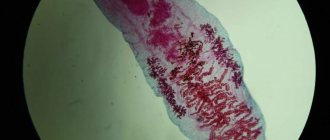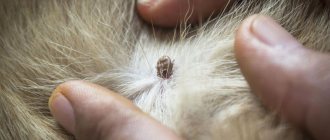How to properly give deworming pills to your cat
Our readers successfully use Intoxic to get rid of parasites.
Seeing how popular this product is, we decided to bring it to your attention. Read more here... The soil and water are replete with parasites. Even if the cat does not leave the house, worm eggs enter the body from raw meat or fish. The source of infection can be dirty shoes, door mats, soil from flowerpots. Once inside, the larvae begin to actively multiply, migrate with the blood, and attach themselves to the intestines and organs. Worms can cause rupture of the intestinal walls and weaken the immune system. When the first symptoms appear, it is important to carry out deworming. Our recommendations will help you on how to properly give your cat anti-worming tablets and how often to carry out courses of treatment.
Subjective symptoms of infestation vary depending on the type of parasite. Cats live with flukes, cestodes and roundworms. In adults, signs are not immediately apparent. In kittens, the malaise is noticeable after 10-12 days. Appears:
- weakness;
- diarrhea or constipation;
- pus in the eyes;
- itching of the anus;
- sharp unpleasant odor from the mouth;
- bloated stomach;
- with a good appetite, weight loss;
- wool falls out.
The presence of symptoms depends on the number of parasites in the body. Sometimes they are completely absent. The phenomena are also inherent in other diseases, so to rule out other pathologies, you need to get tested. The container with the contents is sent to the laboratory within 12 hours after stool collection.
Deworming cats has its own characteristics. Pharmacological agents with different mechanisms of action are sold for them:
- paralyzing the nervous and muscular systems;
- deforming shells of worms (cuticles);
- disrupting metabolic processes.
It is prohibited to give analogues intended for humans. Traditional methods are also irrelevant.
When to give parasite pills to animals? Antihelminthics are administered in the morning on an empty stomach strictly according to the instructions. To solve the problem, 1 appointment is usually enough. If the cat vomits and fragments of worms come out with masses, and worms are visible in the feces, then after 14 days the course is repeated.
If symptoms persist after repeated therapy, it is necessary to show the pet to a specialist. It is possible that the product was chosen incorrectly or laboratory tests are needed. Only a veterinarian will determine the true cause of the pathological condition. It is important to carry out treatment on time, otherwise the animal may die.
Broad-spectrum drugs that destroy all types of parasites are toxic, so they are used extremely rarely for kittens. Ideally, the type of parasite should be identified, then a specific active substance should be selected. The form of release of anthelmintic drugs does not affect the result in any way.
If shortly after the appointment: vomiting, convulsions, heavy breathing appear, you will need the help of a veterinarian. Sometimes there are complications caused by:
- intoxication;
- exceeding the dose;
- intolerance.
If you follow the instructions, negative consequences can be avoided. Before giving medicine, in advanced cases it is better to inject gamavit, which has a detoxifying effect on the body. This reanimates the affected organs and stabilizes the general condition. 6 hours after taking the powder, the animal is given a sorbent - 0.5 spoons of Enterosgel, Polysorb or an activated carbon tablet.
To know exactly the dates of the helminthic infestation, a calendar is created.
Important! You should not give drugs to a pregnant cat or an old animal with a chronic disease. If the cat needs to be vaccinated, the helminthic infestation is carried out within a week.
Pets do not like to take medications. The owners know how difficult it is to get a pill to be swallowed. Obstinate cats desperately resist. If the powder is literally shoved down the throat, violence against the animal will not end well. After suffering stress, she will form a protective reflex, and in the future the procedure will become even more complicated. Resistance is a normal reaction to a stimulus. It's worse if she swallows the powder right away. Apathy is a sign that the disease is progressing and the animal has no strength left to fight.
The kitten is clamped between the knees, the mouth is opened with the left hand, and the syrup is poured in with the right hand. He immediately swallows it along with saliva. But how do you give him the pill the vet prescribed? Choose one of the methods suggested below. The tablet is first broken into several pieces and placed piece by piece under the root of the tongue. It is possible that the kitten will intuitively choose the humane method and receive a dose with food. Half an hour after the reception, breakfast is offered.
Along with the purchase of medicine, a special syringe for tablets is purchased. Using the instrument makes it easier to administer the product into the stomach. The piston quickly pushes a solid tablet into the throat, held in place by a rubber tip. To make the process go smoothly, the medicine is served with water.
You can use a regular syringe. First you need to grind the product, draw in the liquid without the help of a needle, point your hands up your muzzle, and pour it behind your cheek. However, the method has a number of disadvantages.
- It is advisable to administer the suspension dropwise so that a strong stream does not provoke excessive salivation. Otherwise the cat gets scared and spits everything out.
- In order to drip slowly, you need to fix the muzzle for a long time. He won't sit in this position for long. Unlike adult cats, kittens tolerate the procedure calmly.
- It is possible that ½ of the medicine will either remain in the syringe or will not reach its intended destination. In a small dose the drug is ineffective.
The pet is seated on a hard surface with its muzzle away from you. With your gloved left hand, tilt your head back and press on the maxillary arch. Medicine is thrown into the open mouth and blown into the nose to trigger an involuntary swallowing reflex.
The tight swaddling method is used not only for infants. The cat is wrapped in a towel, leaving only the head. Then they sit you on your knees, unclench your teeth with a gloved hand, and throw in the dose. To open the mouth, a finger pad is inserted between the teeth and pressed on the lower jaw. At this time, the other hand holds the withers. They close the mouth and stroke the throat with their hand. The touch will cause the muscles to contract and he will swallow the pill. The aggressive method irritates the animal. In response to violence, the pet will scratch or bite, or leave a puddle.
The cat will not be offended if you repeat the process in a playful way. They put her on her knees, face up, play with her, and stroke her belly. With your left hand, quickly unclench your jaw and push the tablet behind your cheek or under the root of your tongue. If you pre-lubricate it with butter or sour cream, it will slip into the stomach faster. When the animal licks its lips, this is a sign that the dose has reached its destination. This is important because a smart cat may hold it in its mouth and spit it out once it feels free.
If you mix the crushed powder with pate or sour cream, dip your paw into the mixture, a clean animal will lick the mixture off itself. It is not forbidden to apply it to the tip of the nose.
With anthelmintic drops - Stronghold, Prefender is easier. The liquid is only rubbed between the shoulder blades. However, they are more effective for prevention.
Advice! If the medicine has a strong odor, it should be kept in the refrigerator overnight. Under the influence of cold, odor and bitterness are partially neutralized.
Each owner has their own method to feed the medicine. The main rule is to remember to praise the animal and offer its favorite treat. Encouragement will partially relieve stress and form a positive reflex. After therapy, you need to make sure that the animal leaves excrement in the tray. If this does not happen, give a laxative syrup - Lactusan, Duphalac 5 mg.
Removing parasites is much more difficult than preventing infection. That's why:
- The toilet tray is disinfected every other day;
- Meat and fish without heat treatment are not served;
- Outdoor shoes are stored in a cabinet;
- The rug near the front door is washed once a week or more often;
- If several animals live in the house, they are treated together.
In order not to traumatize the psyche of yourself and the cat, it is better to take him to a hospital. The veterinarian will clearly demonstrate how to give the animal medicine.
Prevention of helminthiasis
It is unlikely that it will be possible to completely eliminate the possibility of infecting a cat with worms, because even a cat living in an apartment can swallow worm eggs by tasting the soil from a flower pot. Therefore, prevention of helminthic infestations should be carried out regularly, using special means (the same drugs are used to treat cats for worms).
The most popular among owners are deworming tablets for cats. Some drugs contain one active substance, others contain a complex of substances that allow you to treat mixed infestations without a visit to the veterinarian. When choosing a drug, it is necessary to take into account the age and weight of the cat.
For adult animals, deworming tablets are given 2-4 times a year (two if the cat never goes outside). It is advisable to alternate tablets using two drugs containing different active ingredients. In addition, anthelmintics must be used 14 days before vaccination or mating. Worming pregnant and lactating animals is highly not recommended.
Kittens are given a deworming tablet for the first time at the age of 3 weeks, regardless of the presence or absence of symptoms of infestation. Babies are dewormed for the second time 14 days before vaccination, at the age of 6-8 weeks. The next time the drug is used when the kitten reaches the age of 3 months, then at 6 months, and then 2-4 times a year.
- First method: crush the tablet, mix it with a small amount of water. Draw the resulting liquid into a syringe without a needle. Gently pour the medicine into the cat's cheek, holding the muzzle (so that the cat does not spit out the medicine).
- Second method: place the cat on your lap with its back to you (when trying to escape, the cat will back away, resting its body on your stomach). With one hand, open the cat's jaws, and with the other, place the deworming agent in the cat's mouth. Close its mouth and stroke the cat's throat intensively, but without strong pressure, to provoke a swallowing reflex.
- Third method: crush the tablet, mix the powder with a small amount of canned food or boiled minced meat. Offer a “treat” to your cat.
In addition to tablets, there are drops for worms. They are easy to use - you just need to apply the product to the skin between the shoulder blades. Drops can be used for preventive purposes, but for treatment it is still better to purchase tablets. Stronghold and Prefender drops are popular in Russia.
Before using any drug, carefully read the instructions and follow all manufacturer's recommendations.
Little kittens and puppies are adorable little furballs. But your pet’s round and elastic tummy does not always mean that he had a hearty breakfast. Perhaps this is the first sign of worm infection, and in large numbers.
We suggest you read: How are worms in cats transmitted to people? Prevention of infection and treatment of worms in cats
Young children are also susceptible to helminthiasis from pinworms and roundworms. Due to the low protective barriers of the body, infection with worms occurs at lightning speed. Unfortunately, it is difficult to distinguish it from other ailments due to similar symptoms. Pinworm eggs enter the baby's body with poorly washed vegetables and fruits, through dirty hands and from infected pets.
Vomiting in a person
Worm infestation in humans is a fairly common occurrence, and the owner himself may not be aware of the infection for a long time. Stool analysis rarely detects pinworms, but blood sampling for toxocariasis can detect foreign bodies.
Most often, due to neglect of basic hygiene, after going outside, using the toilet, or before eating, pinworms - helminths from 2 to 12 mm in length - enter the human body.
What are worms?
Doing anything on your own is risky. This can lead to deterioration of the cat's condition and death. The veterinarian performs a detailed analysis of the animal.
The first stage is consultation and medical history collection. The specialist will clarify what kind of vomiting there was and how often the cat vomits blood. The presence of white foam and blood does not necessarily indicate an ulcer. This may be a normal reaction of the body to unchewed food or an unpleasant taste or fur.
If bleeding is detected in the esophagus, surgery is prescribed. Foreign objects are removed, after which the pet remains under the supervision of doctors for some time.
Ulcers and tumors, inflammations and infections with vomiting and blood are treated with medication and diet. Buying medications yourself is fraught with danger. Medicines are selected individually for each pet. The age, immunity, general condition of the cat, and tolerance to various toxins are taken into account.
How can you tell if a kitten has worms?
Of the entire classification of parasites in the body of the cat family, if you try, you can find a whole list. But there are the most common types: round (nematodes) and tape (cestodes).
Nematodes are small representatives of helminths (from 2 mm in length to several centimeters) that settle in the small intestine and live off the blood of the host. This in turn leads to anemia, especially in a small kitten.
Cestodes. These are longer worms (10-65 cm) and more dangerous to the health of their hosts. They parasitize the small intestine, but leave their segments on the surface of the skin (near the anus). Fleas can transmit dangerous larvae to other animals, as well as humans.
During an active life, worms affect the intestinal mucosa and organ tissues of the cat, which initially leads to weakness of the animal, and then to serious problems due to decreased immunity. In addition, worms secrete toxic substances. Some animals die. Therefore, you need to be careful to identify the symptoms of intruders as early as possible. And your breadwinner will grow up healthy and cheerful.
There are general signs of the onset of the disease, and in more severe forms of the disease, it is possible to diagnose specific signs of a specific type of parasite (in laboratory conditions).
What should alert the cat owner first:
- diarrhea;
- constipation;
- if constipation gives way to diarrhea;
- vomiting or retching;
- the appearance of itching in the anus;
- particles of worms appear in the stool;
- there is blood or mucus in the stool;
- the cat's tummy is swollen or unnaturally round;
- weight loss;
- change in mood when eating (absence or increase);
- cough;
- breathing may be difficult;
- the cat's fur loses its attractive appearance (fades, falls out);
- the kitten does not experience growth and development;
- gets tired quickly;
- the mucous surface of the eyes fades;
- The cat had an abortion or premature birth.
All this should alert the breadwinner and prompt him to further, more detailed examinations, both independently and with the help of a veterinarian.
What to do next to find out if the kitten really has worms? Some practical tips.
Of course, the most effective way to determine whether there are worms is to conduct laboratory tests at the first symptoms. What types of tests for worms are there?
- stool analysis.
- washing worm eggs from fur.
- blood test for antibodies.
But remember that infection is not always detected in stool the first time. The kitten should continue to be subjected to careful behavioral examination. If the signs are obvious and the result of the initial stool test is negative, then take it several more times. It was noticed that the fifth attempt is the most guaranteed in terms of accuracy in readings (up to 99%). The same can be said about washing off wool. But a blood test for antibodies is a very effective method. But it's quite expensive. It is harder to take it from a kitten, cat or cat. And you will have to look in some areas for clinics that collect blood from animals. But from the first time all types of invasions that attack the pet’s body will become known, and this will also help to quickly and effectively prescribe treatment.
If there are obvious signs of helminthiasis, do not be upset and do not self-medicate.
Contact a specialist who, using laboratory tests, will determine which category of worms are in the cat’s body and prescribe targeted treatment. After all, when treating a certain type, drugs that are completely useless for destroying other types of worms can help.
Our readers successfully use Intoxic to get rid of parasites. Seeing how popular this product is, we decided to bring it to your attention. Read more here...
Veterinary pharmacies always stock a variety of anthelmintic drugs for kittens and cats. There are a great variety of tablets, capsules, and suspensions for treating parasites, but they all have different side effects and have different effects on the cat’s body. In this article we will look at what can happen to a cat after taking deworming tablets.
What to do, how and how to help?
There are no options; an animal can only be cured of worms with anthelmintic drugs . Most often, several types of parasites coexist in a cat’s body. Therefore, complex broad-spectrum medications should be used for treatment. High-quality drugs rarely have side effects and are quite effective. When using, you should follow the recommendations in the instructions and follow the dosage. The active substance can be in the form of tablets, drops, powders, suspensions.
If an animal suffers from external pests, such as fleas, then first of all you need to get rid of them, and then exterminate the helminths.
Anti-worming medications for cats:
- Pyrantel, Drontal, Parasicil, Kanikvantel, Stronghold, Profender and others.
If the pet is weakened and has other health problems, then it is better to carry out treatment under the supervision of a veterinarian. This is especially true when kittens are sick. Poisoning parasites, if they are in large quantities, can cause intoxication of the animal. Your veterinarian can recommend medications to support your cat and remove toxins after deworming.
When to feed a cat after deworming tablets
There is no exact answer here. It all depends on the type of medicine used. However, on average it is not recommended to feed a cat within 2 hours after taking the drug.
What to do in such a situation? To get started, we recommend reading this article. This article describes in detail methods of controlling parasites. We also recommend that you consult a specialist. Read the article >>>
In particular, during the treatment of worms in cats, it is important to feed them high-calorie food. Worms living in the intestines rob the cat of the nutrients necessary for its life.
In order for the animal to receive the necessary nutrients during the treatment of worms, it is necessary to feed the cat food that is enriched with protein and fat. It is important to eat meat products and/or eggs, and in a cat’s diet this cat food should account for about 60% of the total diet. To increase the amount of fat in the diet, you can add a little olive oil to the feed.
Also, during treatment, you can temporarily switch your cat to a kitten diet, which is much higher in calories than a diet for adult animals. Only here it should be taken into account that if the cat reacted unfavorably to changes in the diet or it once had pancreatitis, it is better not to change the diet.
What are the dangers of having parasites in cats?
Cats can get 2 types of parasitic worms: tapeworms and roundworms . In addition, they can exist together and coexist perfectly. Most helminths of these groups can settle in humans. A cat infected with helminthiasis poses the greatest risks to small children, who can hardly keep a distance when interacting with the animal. That is, the presence of worms in an animal living in the house creates a high risk of infection for humans.
But not only people feel discomfort if worms appear in their body. The cat is an intelligent creature and also suffers from health problems. Worm infestation in cats can significantly ruin a pet’s life, and in the worst case, lead to death. The cause of fatality when cohabiting with parasites can be the following factors:
- Intestinal obstruction, which can be caused by a large accumulation of worms.
- Poisoning by helminth waste products.
- Exhaustion of the body due to a deficiency of vital substances. Especially in combination with other animal diseases.
Kittens suffering from helminthic infestation may be stunted in growth and development. When a growing body is poisoned by toxic waste products of worms, it does not receive enough necessary nutrients and vitamins. A kitten may even die from a large number of parasites.
It is possible to defeat parasites!
Antiparasitic Complex® - Reliable and safe removal of parasites in 21 days!
- The composition includes only natural ingredients;
- Does not cause side effects;
- Absolutely safe;
- Protects the liver, heart, lungs, stomach, skin from parasites;
- Removes waste products of parasites from the body.
- Effectively destroys most types of helminths in 21 days.
There is now a preferential program for free packaging. Read expert opinion.
Treatment of helminthiasis
If the owner of an animal suspects that his pet is still infected with helminths, the first step is to remove the parasites from the body. Delaying treatment for a cat is dangerous - parasites tend to multiply in huge quantities.
Treatment methods aimed against worms in an animal may differ depending on the age of the individual. As a rule, veterinary pharmacies have all the necessary drugs, some are able to remove parasites after one use. Many people in vain consider traditional methods to be effective, however, medications intended for people or dogs are useless in treating cats.
The owner should pay attention to the behavior of the pet after using the drugs.
Roundworms are the ones that most often appear in a kitten’s vomit. This is a warning sign! He says that the parasites have multiplied in incredible numbers and the pet’s intestines have lost their patency.
If the cat starts vomiting and worms are visible in the feces, it is necessary to repeat the drug after 2 weeks. An adult begins to show signs of illness much later than a small kitten. Treatment of worms in small kittens is recommended to be carried out in specialized animal hospitals, under the supervision of specialists. Unlike an adult cat, a small kitten is required to take medications twice, and after a couple of weeks the course of treatment is repeated without fail. This is due to the fact that it is much more difficult to remove parasites from a fragile organism than from an adult pet. It is important to note that medications must be correctly selected and calculated for the height and weight of the kitten.
Bibliography
- Centers for Disease Control and Prevention. Brucellosis. Parasites. Link
- Corbel MJ Parasitic diseases // World Health Organization. Link
- Young EJ Best matches for intestinal parasites // Clinical Infectious Diseases. — 1995. Vol. 21. - P. 283-290. Link
- Yushchuk N.D., Vengerov Yu.A. Infectious diseases: textbook. — 2nd edition. - M.: Medicine, 2003. - 544 p.
- Prevalence of parasitic diseases among the population, 2009 / Kokolova L. M., Reshetnikov A. D., Platonov T. A., Verkhovtseva L. A.
- Helminths of domestic carnivores of the Voronezh region, 2011 / Nikulin P. I., Romashov B. V.
The best stories from our readers
Topic: Parasites are to blame for all troubles!
From: Lyudmila S. ( [email protected] )
To: Administration Noparasites.ru
Not long ago my health condition worsened. I began to feel constant fatigue, headaches, laziness and some kind of endless apathy appeared. Problems also appeared with the gastrointestinal tract: bloating, diarrhea, pain and bad breath.
I thought it was because of the hard work and hoped that it would go away on its own. But every day I felt worse. The doctors couldn’t really say anything either. Everything seems to be normal, but I feel like my body is not healthy.
I decided to go to a private clinic. Here I was advised, in addition to general tests, to get tested for parasites. So in one of the tests they found parasites in me. According to doctors, these were worms, which 90% of people have and almost everyone is infected, to a greater or lesser extent.
I was prescribed a course of antiparasitic medications. But it didn’t give me any results. A week later, a friend sent me a link to an article where some parasitologist shared real tips on fighting parasites. This article literally saved my life. I followed all the advice that was there and after a couple of days I felt much better!
Digestion improved, headaches went away and the vital energy that I so lacked appeared. To be sure, I took the tests again and no parasites were found!
Anyone who wants to cleanse their body of parasites, no matter what types of these creatures live in you, read this article, I’m 100% sure it will help you! Go to article>>>
Breeders make every effort to protect their pets from diseases. But it is impossible to foresee everything, and your beloved four-legged animals are sometimes affected by pathogenic organisms.
If a cat vomits worms, this is a sign of a severe parasitic infestation. Therapeutic measures should be taken immediately.
When and why does a cat vomit worms?
Alas, this only happens in cases of very severe parasitic infestation, when the worms simply do not fit into the animal’s digestive system. Simply put, if it comes to lumps of worms in the vomit, the cat needs to be shown to a veterinarian as soon as possible.
This does not always happen and not with all helminthic diseases. Thus, cestodes (flatworms) may not make their presence known at all, with the exception of segments in the feces. This happens because parasites of this type are too firmly fixed in the digestive tract of the animal, and therefore contractions of the intestines cannot push them out.
But! If there are many cestodes, or the individual is too large and secretes an incredible amount of toxins, the animal experiences severe, debilitating vomiting (a consequence of critical intoxication).
It can be so severe that large pieces of flatworms can come out along with the vomit. And this is not a good sign at all, indicating critical intoxication. In such cases, the pet feels very bad.
Mechanisms of helminthic vomiting
In a similar way, even trematodes can “make themselves known,” many species of which are not found in the intestines at all, living in the liver, gall bladder and pancreas. The reason for this is the same intoxication, although the worms themselves seem to have “nothing to do with it.”
It develops as follows:
- When flukes parasitize the bile ducts, the result of their activity is sluggish chronic inflammation, accompanied by the release of large amounts of mucus.
- This same mucus, as well as “remnants” of the membranes of the bile ducts, may well tightly block and plug the ducts themselves.
- This leads to the fact that the pressure of bile in the bladder begins to increase, since the normal outflow of secretions into the lumen of the small intestine is impossible. It has nowhere to go, and therefore the bile begins to gradually be absorbed into the blood. This pathological condition is called "cholemia". It is extremely difficult, accompanied by severe vomiting, and seizures resembling epileptic seizures are not uncommon.
It happens that vomiting develops a little differently. So, the pressure of bile in the clogged gallbladder increases, and gradually becomes such that the “dam” breaks through. Vomiting with bile develops, but often the trematodes themselves are often found in the masses leaving the animal, which are literally washed out of the liver.
But this is the least of a sick cat’s problems. The fact is that a powerful influx of bile into a half-empty intestine is fraught with very serious consequences, even death.
If the cat begins to vomit, and worms or pieces of them come out along with the vomit, then this is in any case very bad, and you need to show your pet to the veterinarian as soon as possible.
The cat vomited worms: 5 reasons
The infestation of animals by parasites is the rule rather than the exception. Pets that do not walk outside are also not immune from helminthiases. Worm eggs and larvae are everywhere: in the ground, crowded places, tap water, food.
Upon contact with outer clothing, shoes, or water, roundworms and nematodes enter the body.
Vomiting of worms is a consequence of a number of reasons:
- Severe worminess. In the absence of anthelmintic prophylaxis, helminths multiply quickly, and the body rejects the excess.
- Intestinal obstruction. An excessive number of worms creates congestion in the digestive organ, disrupting peristalsis.
- Intoxication. Nematodes and Giardia produce toxins. Vomiting is a protective reflex during poisoning; some parasites are released in the vomit.
- Damage to internal organs. Worms cause inflammatory processes in the stomach, liver, even cirrhosis. Reflexive evacuation of stomach contents is one of the symptoms of organ damage.
- Reaction to an anthelmintic drug.
Vomiting is a serious symptom that indicates a serious condition of the animal.
What are worms?
Cats can easily pick up a wide variety of E. coli, including worms, which can result in them vomiting.
If a parasite enters an animal’s body, a number of symptoms occur. But there are also cases when there are no symptoms until there are a lot of them in the pet’s body
And a person learns about parasites only when the cat vomits worms. Some species can be easily transmitted from person to animal and vice versa. Therefore, you need to constantly carry out preventive measures for all animals and not forget about yourself.
© shutterstock
How do worms come out through vomiting?
The animal's immune system is able to independently resist parasites. Poor nutrition, care, and chronic diseases undermine the defense system, and worms actively multiply.
Once inside, the worms cling to the intestinal microvilli and feed on the juice produced to digest food. A lack of digestive juice disrupts the food processing process. Peristalsis is disrupted, congestion forms, which the kitten’s body tries to get rid of by vomiting. Nematodes and roundworms live mainly in the intestines and come out with the contents of the intestines.
Worm larvae migrate through the intestines into the intrahepatic bile ducts. The secretory function of the liver is impaired. Excess bile enters the blood, cholemia develops, accompanied by vomiting.
Regardless of the type, parasites in the acute phase cause allergies in the host. The immune system intensively produces antigen.
A high concentration of antibodies causes degenerative processes in organs where larvae and adult parasites accumulate. If the digestive system is not functioning well, the remains of undigested food have a toxic effect with manifestations of the gag reflex.
What parasites live in cats?
There are many types of parasites that can live in the body of cats. In total there are about 30 species. They are distinguished into flat and round.
Flatworms:
- Tape (cestodes): tapeworms, tapeworms.
- Flukes (trematodes). Infection with trematodes is also called opisthorchiasis.
Roundworms:
- Roundworms.
- Toxocars.
- Nematodes.
- Hookworms.
All types of these parasites can live in the human body. That is why it is simply necessary to find and neutralize helminths in a cat in a timely manner. If a pet is found to be infested with one or another pest, all family members should undergo prevention along with pet therapy. It is advisable to carry out a general cleaning with disinfection of the room and treatment of all things.
The cat vomited worms: what to do
The presence of parasites in the vomit indicates an advanced form of helminthiasis. The pet must be taken to a veterinarian for examination as soon as possible. The doctor will assess the condition of the predator and, based on the test results, determine what damage has been caused to organs and systems.
The breeder tells the doctor about the pet's behavior in the previous month. A description of the symptoms will help you understand how long the predator has been sick.
Signs of infestation:
- loss of appetite: refusal to eat or, conversely, eating a lot;
- bloated stomach;
- upset stool, frequent diarrhea with a strong odor, constipation;
- decreased activity, drowsiness;
- hair loss;
- allergy symptoms: cough, watery eyes;
- irritability, avoids contact, does not give in to hands;
- rubs and licks the anus.
The doctor will prescribe treatment taking into account the presence of complications. After completing anthelmintic therapy, the doctor will explain how to use the medicine for preventive purposes.
Symptoms of worm infection
There are many symptoms that may indicate the presence of worms in a cat. For example, weakness. The cat becomes passive to entertainment, its fur becomes dull, diarrhea appears, and in some cases constipation. Often signs of helminths can be purulent fluid that comes out of the eyes. Some animals vomit. Also, the most likely sign is the stomach; as a rule, in the presence of parasites in the body, it is tight and swollen.
If your pet starts vomiting and worms are found there, this is a very serious symptom! Urgent consultation and immediate treatment is required!
Many sick cats scratch and chew their anus. At the same time, an unpleasant odor appears from the animal’s mouth. Each animal organism tolerates helminths differently. Some individuals begin to absorb food and do not gain weight, but rather lose it, others refuse to eat, since the slightest ingestion of food into the animal’s body causes vomiting. Paying attention to these symptoms should not immediately make a diagnosis. It is quite possible that this is another disease that is not related to worms.
First aid
Severe symptoms may occur in the evening when veterinary clinics are closed.
The pet owner can provide first aid independently.
- The predator is given plain water (not by force). The liquid will help remove residual toxic substances and relieve spasm of the intestinal muscles.
- Refuse to feed, especially dry food. Food provokes attacks of nausea. A predator may choke on pieces of food.
- Sorbents are given to block the action of toxic substances; activated carbon (1 t/kg) or Phosphalugel (0.5-1 mg/kg) are suitable.
As soon as the pet's condition improves, it is taken to the veterinarian.
What to do if your cat is infected with worms
If your kitten vomits worms, take him to the vet immediately. Only he will be able to confirm the disease after conducting a series of examinations. You should not make a diagnosis yourself, because it may not be parasites at all. Also, you should not treat your pet without consulting a doctor. After all, each individual type of worm requires a specific drug.
Also, you should not use broad-spectrum medications, they can only cause harm and cause symptoms such as diarrhea and weakness, and the pet may also vomit.
Drug treatment
Veterinary pharmacies offer a variety of anthelmintic drugs. For severe infestations, treatment is prescribed by a doctor. He selects a remedy based on the disease, clinical picture, and condition of the cat.
Medicines differ in dosage form and methods of administration.
The dosage and treatment regimen are determined by the veterinarian and, if ineffective, adjusted.
| name of the drug | dosage form | dosage | contraindications |
| Drontal | pills | tablet per 4 kg of cat's weight | age up to 21 days, weight less than kg |
| Kanikquantel Plus | tab. | 1/10 kg | up to 3 weeks, pregnancy |
| Milbemax | tab. | 0.5 tab./kg | up to six months, less than 0.5 kg |
| Prazitel | suspension | 1 ml/kg | pregnancy |
| Prazicide | susp. | ml/kg | less than 3 weeks |
| Prasimek-S | pills | 2/2.5 kg | up to 2.5 months, |
| Helmintal K | drops | 0.1 ml/kg | – |
Drops are applied to the skin, in places inaccessible to licking. For kittens and pregnant females, therapy is carried out carefully. If health deteriorates, discontinue the drug and contact a veterinarian.
How and with what to treat your pet?
Treatment of the animal should begin only after a thorough examination. First of all, you should conduct a stool analysis and determine the presence of worms in your pet. To do this, you need to collect his feces and take him to the laboratory. The material for analysis is placed in a clean, sterile container. What is important in this matter is that the feces must be delivered within 8 or 12 hours from the moment of collection.
Treatment of the animal should begin only after a thorough examination.
Some owners neglect this rule, and their animal dies during baiting. Therefore, first of all, you should determine the type of worms. Then identify concomitant diseases. You need to understand that some drugs are designed specifically for an adult animal or, conversely, for a kitten. You also need to understand that a drug that removes roundworms may not work on tapeworms, or vice versa.
Important! If the drug is chosen incorrectly, the animal may begin to show signs of intoxication.
You also need to carefully choose the place where this medicine is sold. For example, it is best to buy the drug at a veterinary pharmacy. It is there that the probability of purchasing a fake is minimal.
It is best to give the drug to small kittens starting at two months of age.
Also advice for owners of small kittens or old animals. It concerns the fact that you should not use a product that is applied to the withers. These drugs are overly toxic and can cause severe harm to your pet's body. Although at this age, worms appear most often in cats, because the body is especially weakened, so it is very important to know the symptoms of infection and use the correct treatment.
It is best to give the drug to small kittens starting at two months of age. It should also be taken into account that worms are expelled from an otherwise healthy animal’s body.
After everything that has been said above, you can figure out how to understand that a cat has worms, what symptoms are present with this infection, and how to deal with it. But there is another, no less important issue, it concerns the prevention of the animal and proper care for it.
It is prohibited to drive away parasites from animals that are nursing kittens or during their pregnancy.
Traditional methods of treatment
Only anthelmintic drugs can cure severe forms of parasitic infestations. But folk recipes will help speed up the healing process. The use of alternative methods is agreed with the doctor.
Medicines used to treat humans can also be given to four-legged animals, only in a smaller dosage.
Home Recipes:
During therapy, the condition of the furry friend is monitored.
Roundworms in cats
Roundworms in cats are parasitic in the gastrointestinal tract, but can affect other organs. Diseases caused by roundworms are called “nematodes”. Nematodes have an elongated fusiform body. The sizes of roundworms range from 1 mm to several tens of centimeters. Nematodes are dioecious helminths. Females are usually larger than males.
The development of roundworms, depending on the species, occurs both with and without the participation of an intermediate host. With the feces of the animal, the female nematode releases eggs or larvae, which become invasive in the external environment. Cats become infected through nutritional means by ingesting a helminth egg. A cat infects its kittens when feeding milk.
The most common causes of roundworms in cats are toxocariasis and toxascariasis.
Toxocariasis in cats
The main source of the disease is infected cats, which excrete Toxocara eggs in their feces and larvae in their milk when feeding. Adult worms parasitize in the small intestine, larvae - in the lungs, bronchi, liver, heart, and muscles.
Kittens have a hard time suffering from the disease. A severe infestation can be fatal when a large number of helminths poison the pet’s body with toxins. The cause of the inevitable death of an animal can be the formation of a “tangle” of worms, which clogs the intestines and causes rupture of its walls.
Toxascariasis in cats
Toxascariasis most often affects animals older than 6 months. Helminths parasitize in the small intestine, stomach, and sometimes in the bile ducts of the liver and pancreas.
Vomiting of worms in a cat - as a result of the action of anthelmintic medication
Most modern anthelmintic drugs of combined action are against several types of parasitic worms. The medications are potent, incorrect dosage causes intoxication and vomiting. The dose is calculated based on the cat's weight. It is better to be weighed in the clinic.
Another cause of nausea is the toxic effects of dead parasites. To reduce the toxic effect, absorbents are given in parallel with anthelmintic drugs.
How do you know if an animal is sick?
In addition to all the above types of worms, there may be other parasites that also cause great harm to a cat's health. Almost always, the signs of worm penetration in cats are identical, these are symptoms such as:
- diarrhea;
- frequent constipation;
- diarrhea, which often changes to constipation;
- vomiting, and in the most severe cases, the pet may vomit blood or worms themselves;
- Worms appear around the anus or on the stool itself.
In addition to all this, the pet can lose weight very sharply, its belly becomes rounded and swollen. A cat can also “ride” on its butt, the reason for this is severe itching caused by the presence of worms. As mentioned above, the animal's stool may be mixed with blood or mucus. The pet's appetite changes dramatically, from severe hunger to the fact that the animal does not want to eat food at all. Coughing and shortness of breath are also possible.
Can a person get worms from a cat?
Unfortunately yes. During licking, lamblia and roundworm eggs fall through the mouth onto the fur, and from there onto the person’s hands. You can become infected by washing the litter box without gloves. The pet is usually allowed to sleep anywhere. Wool remains on the chair or sofa; upon contact with the surface of the furniture, the larvae get on the skin.
Infection with helminthiasis through contact with a pet is not a reason to abandon the animal. Anthelmintics, which are given to prevent diseases, will help protect your cat from toxoplasmosis and ascariasis.
Rules of care and prevention of infection
It is important to remember here that it is prohibited to drive away parasites from animals that are nursing kittens or during their pregnancy. Typically, prophylaxis is carried out once every six months. If you plan to breed a cat, then you need to expel the parasites 2 weeks before the specified date.
You need to monitor your pet's condition after taking the medicine. If any signs of severe intoxication appear, you should immediately contact a veterinarian. Also, you cannot use several products at the same time. For example, driving away worms along with fleas.
You need to monitor your pet's condition after taking the medicine.
If intoxication does occur, the first thing you need to do is give your pet any sorbent and then go to the vet.
To prevent your animal from getting worms, you should follow some rules of prevention. If you follow them, and also know the main symptoms of infection and treatment rules, then worms will not take root in cats.
The first step is to make sure there are no fleas. They are known to carry parasites very often. Feeding live fish or meat should be avoided. It is necessary to promptly disinfect the cat's potty and change its contents. It is best to store shoes in a separate place. And, of course, we must not forget about personal hygiene.
Feeding of live fish or meat should be avoided
If it has already been discovered that your pet has worms, you should follow strict rules of personal hygiene. As mentioned above, many types of worms are transmitted very quickly from animal to host. Therefore, after each contact with the cat, you need to wash your hands thoroughly. Then, you need to make sure that the animal does not eat from the same dishes as the person and does not touch his food.
You should know all the symptoms of an animal infection, and if it does occur, then begin treatment immediately. You cannot wait until the worms completely attack the pet’s body and thereby cause irreparable harm to it. You should also remember that any infectious infection is not in vain.
Advice! After the worms are driven away, you need to support your pet’s body with special vitamins and medications.
The veterinarian conducts a timely examination of the animal and determines the presence of any abnormalities
It is best to stick to a schedule of regular visits to your veterinarian. He conducts a timely examination of the animal and determines the presence of any abnormalities. After this, you can be sure that your pet is completely healthy.
Unfortunately, helminthic infestations in domestic animals are extremely common. It just so happens that worms are very secretive creatures, and owners are not always aware of their existence. Of course, with the exception of those cases when a cat vomits worms: then any breeder will understand that not all is well.











